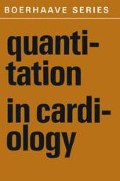Abstract
Application of dynamic and quantitative methods to exercise electrocardiography has lagged partly because of technical difficulties in acquiring exercise electrocardiographic signals and partly because of limitation imposed by the conventional means of ECH registration. Contemporary methods relieve these restrictions and permit changes in response to exercise stress to be measured as they occur, so that the time-course of response becomes a significant variable. This permits the adoption of an exercise stress method which becomes part of a closed feedback loop with individual response to exercise determining the cut off point of the stress. Such a stress test is shown to be reproducible to a satisfactory degree and effective in detecting ischemic heart disease.
A visual method for quantitating exercise ST segment response is illustrated. Its use will reduce interobserver variation in the evaluation of exercise ECGS. A computer method of processing exercise ECGS is described. It eliminates human variability in measurement as well as reducing physician time and effort requirements in evaluating exercise ECG response.
Supported By Grant He-11310-03 of the U.S. Public Health Service, the Alabama Heart Association, and by clinical Research Center Grant 5M01-FR-00032-10.
Access this chapter
Tax calculation will be finalised at checkout
Purchases are for personal use only
Preview
Unable to display preview. Download preview PDF.
References
Robb, G. P. & Marks, H. H., Latent coronary artery disease: determination of its presence and severity by the exercise electrocardiogram. Amer. J. Cardiol. 13, 603(1964).
Sheffield, L. T. & Reeves, T. J., Graded exercise in the diagnosis of angina pectoris. Mod. Cone, cardiov. Dis. 34, 1 (1965).
Friedberg, C. K., Jaffe, H. L., Pordy, L. & Chesky, K., The two-step exercise electrocardiogram. A double-blind evaluation of its use in the diagnosis of angina pectoris. Circulation 26,1254 (1962).
Rowell, L. B., Taylor, H. L., Simonson, E. & Carlson, W. S., The physiologic fallacy of adjusting for body weight in performance of the Master two-step test. Amer. Heart J. 70, 461 (1965).
Lester, F. M., Sheffield, L. T. & Reeves, T. J., Electrocardiographic changes in clinically normal older men following near maximal and maximal exercise. Circulation 36,5 (1967).
Hermiston, R. T. & Faulkner, J. A., Prediction of maximal oxygen uptake by a stepwise regression technique.J. appl. Physiol. 30, 883 (1971).
Lester, M., Sheffield, L. T., Trammell, P. & Reeves, T. J., The effect of age and athletic training on the maximal heart rate during muscular exercise. Amer. Heart J. 76, 370 (1968).
Sheffield, L. T., Holt, J. H. & Reeves, T. J., Exercise graded by heart rate in electrocardiographic testing for angina pectoris. Circulation 32,622 (1965).
Hellerstein, H. K., Exercise therapy in coronary disease. Bull. N. Y. Acad. Med. 44, 1028 (1968).
Blackburn, H., et al., The exercise electrocardiogram: Differences in interpretation. Report of a technical group on exercise electrocardiography. Amer. J. Cardiol. 21, 871 (1968).
Sheffield, L. T., Conroy, D. V., Holt, J. H., Lester, F. M. & Reeves, T. J., Diagnosis of coronary artery disease by on-line computer processing of the exercise electrocardiogram. Proceedings of the 21st Annual Conference on Engineering in Medicine and Biology, p. 40.1, November 1968.
Sheffield, L. T., Holt, J. H., Lester, F. M., Conroy, D. V. & Reeves, T. J., On-line analysis of the exercise electrocardiogram. Circulation 40,935 (1969).
Blackburn, H., Keys, A., Simonson, E., Rautaharju, P. & Punsar, S., The electrocardiogram in population studies - A classification system. Circulation 31,1160 (1960).
Riley, C. P., Oberman, A. & Sheffield, L. T., Unpublished data.
Editor information
Editors and Affiliations
Rights and permissions
Copyright information
© 1971 Leiden University Press, Leiden, The Netherlands
About this chapter
Cite this chapter
Sheffield, L.T. (1971). Quantitative Approach to Exercise Testing for Ischemic Heart Disease. In: Snellen, H.A., Hemker, H.C., Hugenholtz, P.G., Van Bemmel, J.H. (eds) Quantitation in Cardiology. Boerhaave Series for Postgraduate Medical Education, vol 8. Springer, Dordrecht. https://doi.org/10.1007/978-94-010-2927-8_8
Download citation
DOI: https://doi.org/10.1007/978-94-010-2927-8_8
Publisher Name: Springer, Dordrecht
Print ISBN: 978-94-010-2929-2
Online ISBN: 978-94-010-2927-8
eBook Packages: Springer Book Archive

